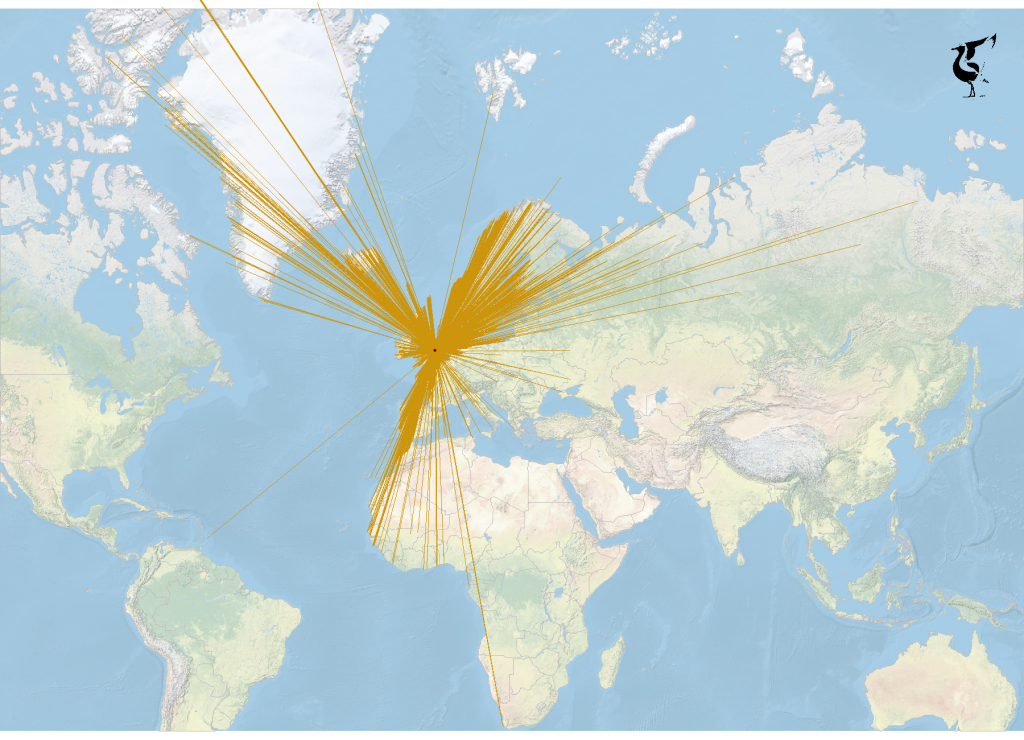Many of the 300,000 birds that we have ringed on the Wash been re-encountered there, some decades after their initial ringing – our longevity records for both Oystercatcher and Bar-tailed Godwit are over thirty years – but ‘our’ birds are also encountered elsewhere. Indeed 8,500 individuals (of 28 species) have been recorded away from the Wash, with over 6,000 of these recorded in another country. So where do birds go when they are not on The Wash?

As the map shows The Wash really does connect the world, with birds flying to and from locations on four continents. Of course, some birds, notably Redshank, live their entire lives on the Wash – breeding on the saltmarsh in summer and feeding on the mudflats in winter. Others, though, as the map shows, travel long distances.
Our longest-distance visitors are undoubtedly Knot and Sanderling. Both breed in the high Arctic, and while many spend the winter on The Wash, others stop over only for a few weeks in the autumn before heading on to beaches in western Africa or, more rarely, South Africa (with one ringed Knot and two Sanderling recorded there). In summer, Sanderling are found across a wide swathe of the Arctic, from Greenland through to eastern Siberia; in fact our most easterly recovery is of a Sanderling found 127° east of The Wash. Summer Knot records also come from the high Arctic, but more typically from Greenland and Canada (primarily Ellesmere and Baffin Islands), as far as 86° west. Knot also provide our only Caribbean record, with one, probably storm-driven, bird found in Barbados in 1971.
Like the Knot, summer Turnstone recoveries tend to come from Greenland, but a dozen Finnish records suggest some breed in more easterly locations too. Both Bar-tailed Godwit and Grey Plover breed in Arctic Russia, with two records apiece from Siberia (godwits inland, plovers from the mouth of the Ob and Yenisei rivers). While some remain here for the winter, individuals of all three species are headed for western Africa, stopping off on The Wash in the autumn on the way. Another species that winters in western Africa is the Ruff, but this is more a bird of freshwater habitats and it provides our two Malian recoveries. While Ruff used to breed on the Ouse/Nene Washes, they no longer regularly do so and most birds on The Wash come from breeding grounds in eastern Europe.
Dunlin is our most ringed, and recovered, species and three races are found on The Wash. Birds of the arctica race breed in north-east Greenland (though, as yet, we have had no direct recoveries from there) and migrate through Iceland and Britain in the autumn on their way to wintering grounds in western Africa. Those of race schinzii breed further south, in southern Greenland, Iceland, northern Britain and southern Fennoscandia. These birds, too, winter in western Africa (and also southern Europe), passing through The Wash in the autumn. Birds of the nominate alpina race, on the other hand, come to The Wash largely to spend the winter; these birds breed in northern Fennoscandia east to the Kara Sea (and beyond, although such birds have not been encountered on The Wash).
Not all of the birds visiting The Wash are from the Arctic though, many breed in more temperate latitudes. Several species, particularly Redshank and Black-tailed Godwit breed in Iceland, for instance, while most of our Oystercatcher breed in Norway and our Curlew in Finland. Some of these birds will move further south and west for the winter, sometimes as far as France or Portugal, especially in cold weather (in the same way that birds from the Waddensee will seek more clement conditions on The Wash when temperatures drop there). Closer to home, in the winter, The Wash also hosts many birds that have bred in Britain, either on lowland wet grassland, or on upland moor, although populations of most British breeding waders are under severe threat and decreasing in number.
The rich mudflats of The Wash, then, provide a stage for an ever changing cast of players that come from far and wide. Depending on when you visit, the birds in front of you may shortly be on their way to (or have come from) Canada, Greenland, Siberia, southern Europe, or Africa. Through our ringing activities we can gain some insight into these journeys and provide the information necessary to ensure sites are protected and that the birds can continue to migrate with the best possible chance of success.
